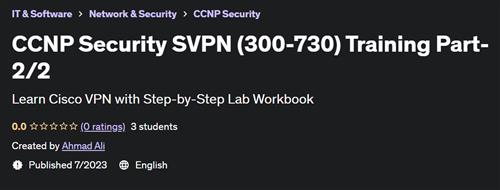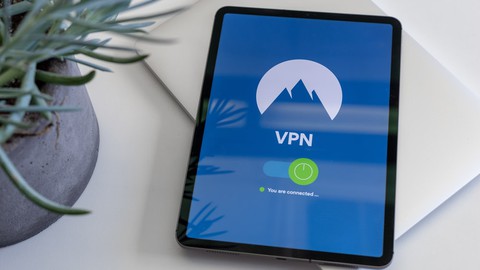Ccnp Security - Svpn 300-730 Part 3/3
Last updated 6/2021
MP4 | Video: h264, 1280x720 | Audio: AAC, 44.1 KHz
Language: English
| Size: 6.46 GB
| Duration: 12h 13m
Covers IKEv2 - FLEXVPN , REMOTE VPN
What you'll learn
Implementing Secure Solutions with Virtual Private Networks v1.0 (SVPN 300-730) is a 90-minute exam associated with the CCNP Security Certification.
Tests a network security engineer on the variety of Virtual Private Network (VPN) solutions that Cisco has available on the Cisco ASA firewall and Cisco IOS software platforms.
This exam tests a candidate's knowledge of implementing secure remote communications with Virtual Private Network (VPN) solutions including secure communications, architectures, and troubleshooting.
The course, Implementing Secure Solutions with Virtual Private Networks, helps candidates to prepare for this exam.
Implementing Site to Site IPSEC VPN on Routers & ASA
Implementing DMVPN on Cisco Routers
Implementing FlexVPN with IKEv2 on Cisco Routers
Implementing Remote Access VPN - CIsco Routers & ASA
Troubleshooting VPNs using ASDM and CLI
Understand VPN Secure Communications Architecture
Requirements
CCNA Routing and Switching Knowledge
Knowledge Basic Network Security Concepts (preferred)
Description
This is the Last part of the 3 Parts for new CCNP SECURITY Concentration Exam SPVN-300-730 covers topics in 3 Parts as given belowPart 1 - CryptoGraphy Concepts , VPN FOundations, IPSEC, Site to Site IPsec VPNPart 2 - covers DMVPN Concepts & IPSec over DMVPN , Part 3 - IKEv2 Focusses on Remote Access VPN on ASA and Routers.FlexVPN ====Available February 24, 2020: Updates to the CCNP certification and training programOn February 24, 2020, Cisco will release new certification exams. New training will roll out over the next several months.If you have started working toward the current CCNP Security certification, keep going. In the new program, you'll receive credit for work you've already completed.======Implementing Secure Solutions with Virtual Private Networks (SVPN 300-730)This exam tests your knowledge of implementing secure remote communications with Virtual Private Network (VPN) solutions, including:Secure communicationsArchitecturesTroubleshootingTo earn CCNP Security, you pass two exams: a core exam and a concentration exam of your choice. The core exam, Implementing and Operating Cisco Security Core Technologies v1.0 (SCOR 300-701), focuses on your knowledge of security infrastructure including network security, cloud security, content security, endpoint protection and detection, secure network access, visibility, and enforcement. You can prepare for this exam by taking the training course, Implementing and Operating Cisco Security Core Technologies (SCOR).Concentration exams focus on emerging and industry-specific topics such as Cisco Firepower, identity services, email security, web security, VPNs, and automation. You can prepare for concentration exams by taking corresponding Cisco training courses.
Overview
Section 1: IPSEC - IKEv2
Lecture 1 IPSEC IKEv2
Lecture 2 IKEv1 vs IKEv2
Lecture 3 IKEv2 - PHASE 1 SA_INIT_AUTH
Lecture 4 IKEv2 - PHASE 2 - CHILD SA
Lecture 5 IKEv2 Platform Support
Lecture 6 IKEv2 Supported VPNs
Section 2: IKEv2 Site-to-Site VPN
Lecture 7 IKEv2 Site-to-Site VPN - Lab Setup
Lecture 8 IKEv2 Site-to-Site VPN - Proposals
Lecture 9 IKEv2 Site-to-Site VPN -Policy
Lecture 10 IKEv2 Site-to-Site VPN -KEYRING
Lecture 11 IKEv2 Site-to-Site VPN -Profile
Lecture 12 IKEv2 Site-to-Site VPN -IPSEC
Lecture 13 IKEv2 Site to Site VPN - Verification
Section 3: FLexVPN
Lecture 14 FLexVPN - IKEv2
Lecture 15 FLexVPN - Capabilities
Lecture 16 FLexVPN - Platform Support
Section 4: FlexVPN Site to Site VPN
Lecture 17 FlexVPN Site to Site VPN - CryptoMaps
Lecture 18 FlexVPN Site to Site VPN - Static VTI - PART 1
Lecture 19 FlexVPN Site to Site VPN - Static VTI - PART 2
Lecture 20 FlexVPN Site to Site VPN - Static VTI - PART 3
Section 5: FLEXVPN - HUB and SPOKE Tunnels
Lecture 21 FlexVPN HUB-SPOKES tunnels
Lecture 22 FlexVPN - Dynamic VTI
Lecture 23 FlexVPN Hub-SPOKE Tunnels - PART 1
Lecture 24 FlexVPN Hub-SPOKE Tunnels - PART 2
Lecture 25 FlexVPN Hub-SPOKE Tunnels - PART 3
Lecture 26 FlexVPN Hub-SPOKE Tunnels - PART 4
Section 6: IKEv2 Authorization Policy
Lecture 27 FlexVPN Authorization
Lecture 28 FlexVPN HUB-SPOKE Routing Issues - Solutions
Lecture 29 IKEv2 Authorization Policy - Configuration - PART 1
Lecture 30 IKEv2 Authorization Policy - Configuration - PART 2
Section 7: FlexVPN - Spoke to Spoke Tunnels
Lecture 31 FlexVPN - Spoke to Spoke Tunnels
Lecture 32 FlexVPN - Spoke to Spoke Tunnels - Configuration Overview
Lecture 33 FlexVPN - Spoke to Spoke Tunnels - Configuration -PART 1
Lecture 34 FlexVPN - Spoke to Spoke Tunnels - Configuration -PART 2
Lecture 35 FlexVPN - Spoke to Spoke Tunnels - Configuration -PART 3
Lecture 36 FlexVPN - Spoke to Spoke Tunnels - Configuration -PART 4
Lecture 37 FlexVPN - Spoke to Spoke Tunnels - Configuration -PART 5
Lecture 38 FlexVPN - Spoke to Spoke Tunnels - Configuration -PART 6
Lecture 39 NHRP Role in FlexVPN
Section 8: SSL VPN Overview
Lecture 40 Remote Access VPN
Lecture 41 What is SSL-TLS
Lecture 42 How SSL-TLS Works
Lecture 43 What is SSL VPN
Lecture 44 SSL VPN - Modes
Section 9: ASDM - Lab Setup Remote VPN
Lecture 45 ASDM - Adaptive Security Device Manager
Lecture 46 ASDM Configuration
Lecture 47 ASDM - GNS3 Setup - PART 1
Lecture 48 ASDM - GNS3 Setup - PART 2
Lecture 49 Remote VPN - Lab Setup
Section 10: SSL Clientless VPN - Configuration
Lecture 50 SSL Clientless VPN - Configuration - PART 1
Lecture 51 SSL Clientless VPN - Configuration - PART 2
Lecture 52 SSL Clientless VPN - Configuration - Verification with ASDM
Lecture 53 SSL Clientless VPN - Configuration - Setup Wizard
Lecture 54 Default Group Policy - Connection Profiles
Lecture 55 New Group Policy - Connection Profiles
Lecture 56 New USER - Assign Group Policy
Section 11: Bookmarks - GROUP URL - ALIAS
Lecture 57 SSL VPN - Bookmarks
Lecture 58 BookMarks - with FQDN - DNS
Lecture 59 Tunnel Group- ALIAS
Lecture 60 Tunnel Group- ALIAS - LAB 2
Lecture 61 Tunnel Group- URL Access
Section 12: SSL VPN - Port Forwarding
Lecture 62 SSL VPN - Port Forwarding
Lecture 63 Port Forwarding - Configurations
Lecture 64 Port Forwarding - Configuration Example 2
Lecture 65 Port Forwarding - Configuration Example 3
Section 13: Smart Tunnels - SSL VPN
Lecture 66 Port Forwarding - Limitations
Lecture 67 Smart Tunnels - SSL VPN
Lecture 68 Smart Tunnels - Configuration Pre-Requisite
Lecture 69 Smart Tunnels - Configuration
Section 14: Full Client SSL VPN - Anyconnect
Lecture 70 SSL VPN - Tunnel Modes
Lecture 71 SSL VPN Tunnel Mode - Configuration PART 1
Lecture 72 SSL VPN Tunnel Mode - Configuration PART 2
Lecture 73 Anyconnect Install - Verify SSL VPN
security engineer,Network Engineers
Free search engine download: CCNP SECURITY - SVPN 300-730 PART 33











